Look no further for an easy-to-follow guide as we explore the steps of how to install seagrass carpet at home in the simplest way. Transforming your space with seagrass is not only a testament to style but also a commitment to sustainable and natural aesthetics.
Let’s delve into the straightforward process, ensuring that you can effortlessly bring the warmth and charm of seagrass into your home.
Contents [hide]
1. Materials for Seagrass Carpet Installation
Installing seagrass carpet requires careful preparation and the right materials to ensure a successful and visually appealing outcome. Here are the essential materials you’ll need for seagrass carpet installation:
- Seagrass Carpet: Purchase natural seagrass carpet in the desired size and style. Measure the area accurately to determine the amount of carpet needed.
- Adhesive or Double-Sided Tape: Choose an appropriate adhesive or double-sided tape designed for use with seagrass carpet. This will help secure the carpet to the subfloor.
- Utility Knife or Carpet Cutter: A utility knife or carpet cutter is necessary for cutting the seagrass carpet to fit the dimensions of the room accurately.
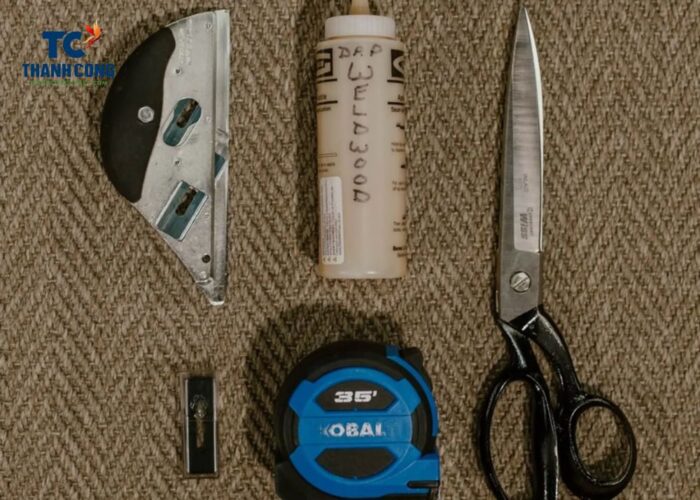
- Measuring Tape: Ensure precise measurements by using a measuring tape. This is essential for accurately sizing and cutting the seagrass carpet.
- Seam Roller: A seam roller helps to ensure proper adhesion of the seagrass carpet to the floor. It’s especially useful in areas where two pieces of carpet meet.
- Trowel or Spreader: If you’re using adhesive, a trowel or spreader is necessary for applying the adhesive evenly across the subfloor.
- Knee Kicker: A knee kicker is a tool used to stretch and secure the carpet, particularly along the edges and in corners.
- Stair Tool (if applicable): If you’re installing seagrass carpet on stairs, a stair tool is essential for achieving a neat and secure fit.
- Seam Tape (if applicable): Seam tape is used to join sections of seagrass carpet seamlessly, ensuring a professional and cohesive look.
- Safety Gear: Gloves and knee pads can provide protection and comfort during the installation process.
- Subfloor Preparation Materials: Depending on the condition of your subfloor, you may need materials such as plywood or underlayment to ensure a smooth and even surface for the seagrass carpet.
2. How to Install Seagrass Carpet?
Step 1: Measure and Plan
The first step in the seagrass carpet installation process emphasizes precision and thoughtful planning. This begins with the accurate measurement of the area where the seagrass carpet is to be installed.
Take meticulous measurements, considering the length and width of the space, ensuring a proper fit.
This is not only an aesthetic consideration but also a practical one, as aligning the fibers in a specific direction can impact the overall appearance and wear of the carpet.
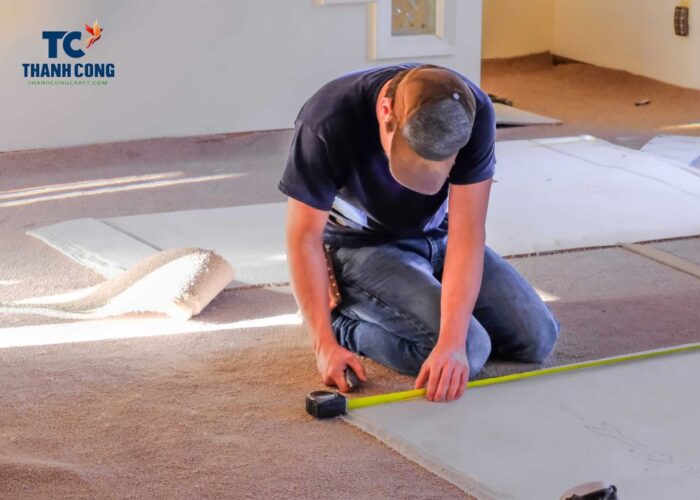
Step 2: Prepare the Subfloor
Ensure the subfloor is clean, dry, and smooth. Make any needed repairs. Consider using plywood or underlayment if required. Proper subfloor preparation is crucial before installing a new floor.
Clean the subfloor thoroughly to remove dust and stains that may affect adhesion. Ensure the subfloor is completely dry to prevent bonding issues. Repair any damage, and for added support, think about using plywood or underlayment.
Follow manufacturer guidelines for optimal results.
Step 3: Cut the Seagrass Carpet
How to fit seagrass carpet? Using a utility knife or carpet cutter, cut the seagrass carpet to fit the dimensions of the room. Double-check measurements for accuracy.
To proceed with the installation accurately, cut the seagrass carpet into pieces that match the dimensions of the room. Use a utility knife or carpet cutter for this task. Ensure to double-check the measurements to ensure precision.
Step 4: Apply Adhesive or Tape
Depending on your chosen method, apply adhesive or double-sided tape to the subfloor. Use a trowel or spreader for even distribution. In this crucial step, the decision to use adhesive or double-sided tape depends on the type of flooring and specific project requirements.
If opting for adhesive, use a trowel or spreader to ensure an even distribution across the entire subfloor. Conversely, if using double-sided tape, apply it along the length of each seam and make sure it is strategically placed to secure the flooring tightly to the subfloor.
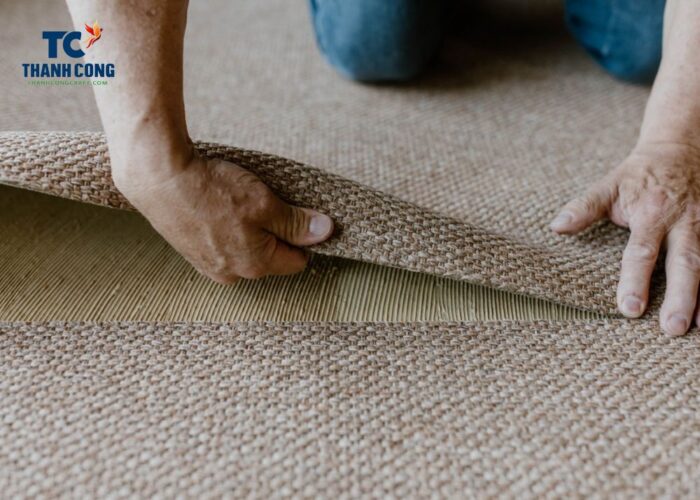
Step 5: Position and Secure
Once the adhesive or tape is applied, the next step involves delicately placing the seagrass carpet onto the prepared subfloor. Take care to align the edges and corners accurately, ensuring a precise fit within the designated area.
A knee kicker, a tool designed for stretching and securing carpets, becomes instrumental in this phase. The use of a knee kicker is particularly effective in ensuring that the seagrass carpet adheres securely to the subfloor, creating a professional and durable result.
Step 6: Trim and Seam
After securing the seagrass carpet, the next step is to trim any excess along the edges and seams. Employ a utility knife for precision in cutting. Take care to follow the contours of the room, ensuring a clean and tailored appearance.
Precision in trimming and seaming is vital for a polished and professional outcome.
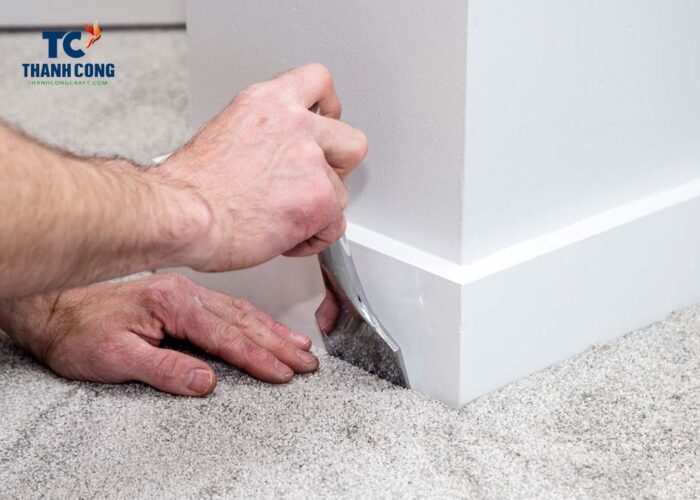
Step 7: Stairs Installation (if applicable)
How to install seagrass carpet on stairs? When installing seagrass carpet on stairs, a specific approach is necessary to achieve a tailored and secure fit. Utilize a stair tool designed for this purpose, ensuring that the carpet conforms snugly to the unique contours of each stair.
Begin by carefully positioning the seagrass carpet on the stairs, making sure to align it accurately with the edges and risers. Tucking the carpet into the crevices and corners of each step for a neat and professional appearance.
Apply adhesive methodically, paying attention to each stair’s surface. Trim the carpet as needed to accommodate the stair nosing and create a seamless and secure installation.
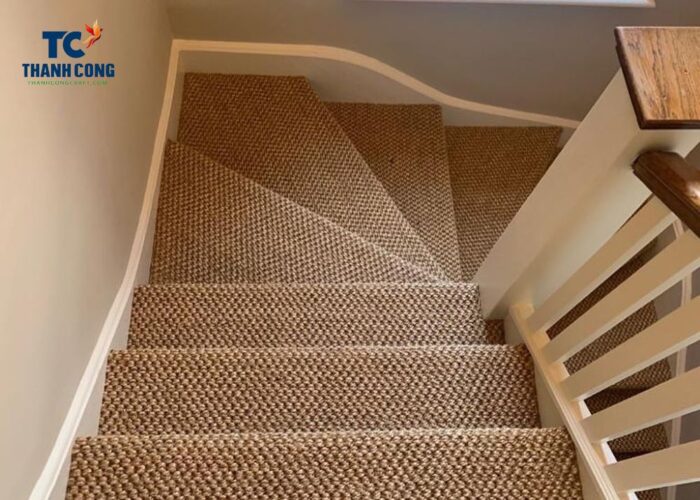
Or to install seagrass carpet on concrete, start by preparing the clean and level subfloor. Apply a moisture barrier if needed, then cut the seagrass carpet to fit. Use adhesive or double-sided tape, position the carpet carefully, and secure it with a knee kicker.
Trim excess and seams, especially on stairs if applicable. Seam rolling ensures proper adhesion. Make final adjustments, walk over the carpet, and allow it to settle for a day or two for a smooth finish.
Step 8: Seam Rolling
After installing the seagrass carpet, the next crucial step is seam rolling, a technique that contributes to enhanced adhesion and a polished, professional finish. Employing a seam roller is essential for ensuring that seams and edges are securely pressed down onto the subfloor.
Consistent and thorough seam rolling is a key element in achieving a finished look that meets professional standards. Take the time to methodically roll over all seams and edges, paying special attention to detail.
Step 9: Final Adjustments
After completing the installation and seam rolling, conduct a final inspection by walking over the entire seagrass carpet. This step allows you to identify any areas that may need last-minute adjustments for a flawless finish.
Trim any excess material, secure edges, and ensure that the carpet lies uniformly across the entire surface. This meticulous attention to detail during the final adjustments ensures a polished appearance and enhances the overall aesthetic of the seagrass carpet installation.
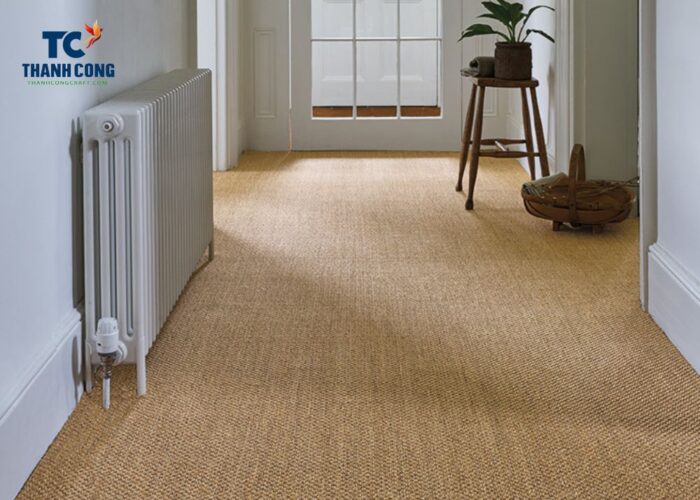
Step 10: Allow for Settling
After completing the installation and final adjustments, it’s essential to allow the newly installed seagrass carpet to settle for a day or two. During this time, any wrinkles or minor irregularities that may have occurred during installation will naturally relax, contributing to a smoother and more uniform surface.
This waiting period provides an opportunity for the carpet fibers to acclimate to the environment, and it allows the adhesive to cure fully. It is recommended to avoid heavy foot traffic and excessive movement on the carpet during this time to ensure a stable and undisturbed settling process.
3. FAQs
3.1 Is seagrass carpet any good?
Yes, seagrass carpet can be a good choice for certain applications. Seagrass is a natural fiber that is durable, resistant to stains, and has a unique, textured appearance. It is particularly well-suited for low-traffic areas and can add a touch of natural elegance to a space.
However, it’s essential to consider that seagrass may not be as soft as some other carpet materials, and it can be susceptible to water damage and fading in direct sunlight.
Therefore, its suitability depends on the specific needs and preferences of the homeowner, as well as the intended use of the carpet.
3.2 Do you need underlay with seagrass? What underlay for seagrass?
Typically, seagrass carpet is installed without an underlay. Seagrass is a natural fiber that has a stiff and coarse texture, and it is often chosen for its durability and natural aesthetic. Using an underlay with seagrass may not be necessary, as the carpet itself provides a firm and stable surface.
However, if extra cushioning or insulation is desired, a thin, non-slip rug pad can be considered. This type of pad can help prevent the seagrass carpet from slipping and add a bit of cushioning without compromising the natural look and feel of the seagrass.
It’s essential to consult with the manufacturer’s guidelines for the specific seagrass carpet you’ve chosen, as they may provide recommendations or precautions regarding the use of underlay.
3.3 How do you get a seagrass rug to lay flat?
To ensure a seagrass rug lays flat, start by allowing it to acclimate in the room for a day or two. Reverse rolling, using heavy furniture on corners, and applying gentle heat can help eliminate curls or bumps.
Additionally, consider using rug grippers or double-sided tape along the edges for extra stability. Regular vacuuming also aids in settling the fibers. These simple steps will contribute to a smoother and flatter appearance for your seagrass rug.
In conclusion, installing seagrass carpet involves a systematic approach to ensure a successful and visually appealing outcome. By following these comprehensive steps, you can confidently enjoy the natural beauty and durability that seagrass carpet brings to your home.
The above article is about “how to install seagrass carpet“, if you have any further questions, don’t hesitate to send thanhcongcraft an email us at info@thanhcongcraft.com or message us at WhatsApp: +84967485411. We are always ready to assist you!


